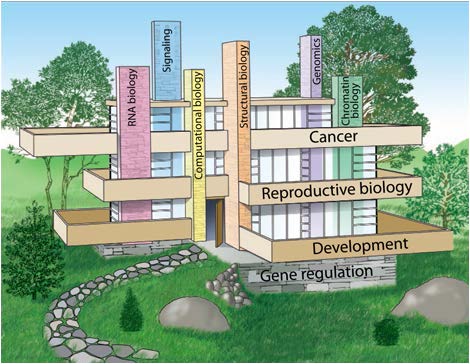Research Focus Areas
The intellectual environment in the Green Center for Reproductive Biology Sciences, as well as in neighboring departments and across campus, is outstanding. It provides a tremendous resource of expertise to the PIs and labs for the proposed studies. Numerous investigators on campus, who are leaders in their fields, work in areas closely related to the following research interests.

The lists below indicate Green Center faculty in bold, and additional colleagues across campus working in the following research areas.
- Biochemistry
Biochemistry
By reconstituting a wide spectrum of macromolecular complexes with biochemically defined components, we aim to recapitulate basic cellular processes in vitro and to ultimately understand the chemistry and mechanism of gene regulation. Dysregulation of the macromolecules of our interest is frequently found in cancers and developmental disorders.
- Cancer
Cancer
Faculty in the Green Center use an interdisciplinary approach that has led to new information about the connections between hormone-regulated gene expression and the gene-regulating effects of chromatin, which has implications for understanding and treating breast cancers, among others.
- Gene Regulation and Genomics
Gene Regulation and Genomics
The coordinated regulation of gene expression in response to intrinsic and extrinsic cellular signals is a fundamental process in biology. We are combining the most powerful techniques from modern biology, as well as the physical and computational sciences, to address specific mechanistic questions that will yield an in-depth understanding of the molecular basis of signal-regulated gene expression.
- Laura Banaszynski
- Cristel Camacho
- Haiqi Chen
- Cheng-Ming Chiang
- Nicholas Conrad
- David Corey
- Ivan D'Orso
- Joel Elmquist
- Janko Gospocic
- Edward Grow
- Joshua Gruber
- Gary Hon
- Ralf Kittler
- Lee Kraus
- Xin Liu
- Ram Madabhushi
- David Mangelsdorf
- Elisabeth Martinez
- Steven McKnight
- Ben Sabari
- Hume Stroud
- Angelique Whitehurst
- Jiang Wu
- Yang Xie
- Jian Zhou
- PARPs and ADP-Ribosylation
PARPs and ADP-Ribosylation
The poly(ADP-ribose) polymerase (PARP) family comprises a diverse set of proteins with a conserved enzymatic activity that catalyzes the covalent attachment of ADP-ribose (ADPR) units from NAD+ molecules on target proteins. We study the roles of PARP proteins on gene expression in various biological contexts using state-of-art tools ranging from biochemistry, genomics and bioinformatics, genetic mouse models, to clinical samples.
- Reproductive Biology
Reproductive Biology
Across campus, our investigators direct basic science, translational, and clinical research programs that focus on advancing understanding of key aspects of women’s reproductive tract health that include fertility, pregnancy, parturition, gynecological cancers, and pelvic floor health, as well as key aspects of men's reproductive tract health including spermatogenesis and urological cancers. The power of mouse genetics, cell biology, physiology, transcriptomics, and genomics is leveraged to elucidate molecular mechanisms that advance understanding of normal physiology and pathophysiology.
- RNA Biology
RNA Biology
In its major role, RNA functions as an intermediate in controlling gene expression, transferring information from genomic DNA to protein molecules. Our investigators study aspects of RNA processing, post-transcriptional regulation, as well as the many RNAs that do not code for protein. Mechanistic studies to elucidate how functional, non-coding RNAs are generated, recognized, and regulated are important for understanding RNA’s role in gene expression and identifying new avenues for developing therapeutics.
- Stem Cells
Stem Cells
Stem cells have the remarkable potential to develop into the mature cells that make up every type of tissue and organ in the body. These cells offer a unique opportunity to understand how the information contained in a single genome is regulated to achieve many cell fates. Stem cell research provides a window into fundamental properties of gene regulation with important implications for regenerative medicine and human health.
- Structural Biology
Structural Biology
Using state-of-the-art structural biology tools including X-ray crystallography, cryo-electron microscopy, and nuclear magnetic resonance, our research groups study the three-dimensional structure and function of macromolecular complexes that control some of the most fundamental cellular processes, such as chromatin regulation and RNA metabolism.
